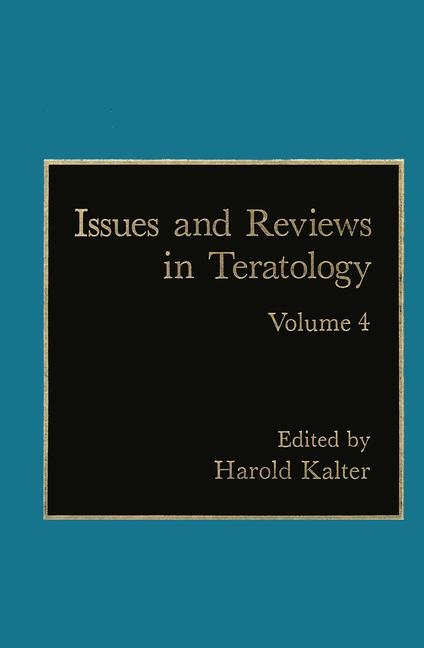
Issues and Reviews in Teratology
Kluwer Academic/Plenum Publishers (Verlag)
978-0-306-42740-4 (ISBN)
- Titel ist leider vergriffen;
keine Neuauflage - Artikel merken
1 Story of a Teratologist.- 1. Early Years.- 2. After the War.- 3. New York Incidents.- 4. Cincinnati in the 1930s.- 5. Becoming a Teratologist.- 6. Mental Retardation.- 7. Unusual Children.- 8. A Side Issue—Acrodynia.- 9. An Unwelcome Episode—Illness.- 10. The Book.- 11. Hobbies.- 12. Reading.- 13. A Geographical Adventure—Israel.- 14. Attempts at Applied Teratology—The National Foundation.- 15. Study Section.- 16. Terathanasia—An Idea.- 17. Thalidomide.- 18. Co-workers.- 19. Patient-Doctor Relations.- 20. My Physicians.- 21. Retiring.- References.- 2 One Hundred Years of Human Embryology.- 1. Introduction.- 2. Early Studies.- 3. The His Era.- 3.1. Wilhelm His.- 3.2. Technical Advances.- 3.3. Anatomie menschlicher Embryonen.- 4. The Era of Monographs.- 4.1. Franz Keibel.- 4.2. Normentafeln.- 4.3. The Manual of Human Embryology.- 5. The Carnegie Era.- 5.1. Franklin P. Mall.- 5.2. The Carnegie Collection.- 5.3. The Carnegie Department of Embryology.- 5.4. The Contributions to Embryology.- 5.5. Abnormal Embryos.- 5.6. George L. Streeter.- 5.7. Embryonic Staging.- 5.8. Prenatal Length and Weight.- 5.9. Prenatal Age.- 5.10. Other Institutions.- 5.11. Histochemistry.- 5.12. Embryological Nomenclature.- 5.13. Placentology.- 6. The Recent Period.- 6.1. The Carnegie Collection.- 6.2. Electron Microscopy.- 6.3. In Vitro Fertilization.- 6.4. Fetology.- 6.5. Prenatal Diagnosis.- 7. The Future.- 8. Summary and Conclusion.- References.- 3 Collection and Scientific Use of Human Embryonic and Fetal Material: 25 Years of Experience.- 1. Introduction.- 2. Methods.- 2.1. Public Relations.- 2.2. Procurement and Transport of Specimens.- 2.3. Laboratory Space, Equipment, and Storage.- 2.4. Postmortem Condition and Artifacts.- 2.5. Methods for Serial Sectioning.- 2.6. Staining Methods.- 2.7. Recording and Retrieval of Information.- 2.8. Financial Aspects.- 3. Results.- 3.1. Intake.- 3.2. Sex Ratio and Seasonal Variation.- 3.3. Nature of Spontaneous Abortions.- 3.4. Malformation Rates.- 3.5. Fetal Growth Standards.- 3.6. Fetal Pathology.- 3.7. Serial Section Collection of Embryos.- 3.8. Monitoring.- 3.9. Organ Culture of Thyroid and Other Organs.- 4. Projects by Scientists Supplied Material.- 4.1. Patterned Appearance of Embryonic Cell Surface Antigens.- 4.2. Emersion of Bioactivation of Xenobiotics in the Fetus.- 4.3. Use of Embryonic and Fetal Tissues for Genetic Engineering.- 4.4. Development of the Human Palate.- 4.5. Closure of the Anterior Neural Tube.- 4.6. Development of Human Embryonic and Fetal Skin.- 5. Discussion.- 5.1. Why Use Human Tissues.- 5.2. The Lost Romance of Human Embryology.- 5.3. The Early Human Fetus: Neglected Stage of Development.- 5.4. Problems in Collecting.- 6. Summary.- References.- 4 Liability to Cleft Lip and Palate: Interpreting the Human Data.- 1. Introduction.- 2. Classification.- 3. Genetic Studies.- 3.1. Basic Observations.- 3.2. The Multifactorial/Threshold (MF/T) Model.- 3.3. Segregation Analyses and Related Studies.- 3.4. Discussion.- 4. Investigations Seeking Environmental Influences on Liability.- 4.1. Geographical Variation.- 4.2. Temporal Variation.- 4.3. Parental Factors.- 4.4. Aspects of Pregnancy.- 4.5. Putative Teratogens.- 4.6. Vitamin Supplementation.- 4.7. Discussion.- 5. Investigations Seeking Indicators of Liability Variation.- 5.1. Minor Anatomical Variation.- 5.2. Additional Defects.- 5.3. Associations of Major Malformations in Families.- 5.4. Fetal Wastage and Sex Ratio.- 6. Interpreting the Human Data.- References.- 5 The Relation between Alcohol Consumption and Pregnancy Outcome in Humans: A Critique.- 1. Introduction.- 2. Pregnancy Outcome in Alcoholic Women.- 2.1. The Fetal Alcohol Syndrome.- 2.2. Epidemiological Studies of Alcoholic Women.- 2.3. Discussion.- 3. Pregnancy Outcome and Moderate Drinking.- 3.1. Measuring Alcohol Consumption in Pregnancy.- 3.2. Low Birthweight and Preterm Delivery.- 3.3. Congenital Malformations.- 3.4. Stillbirth.- 3.5. Spontaneous Abortion.- 3.6. Discussion.- 4. Conclusions.- References.- 6 Experimental Teratology of Ethanol.- 1. Introduction.- 2. Prenatal and Perinatal Mortality.- 3. Teratogenicity.- 3.1. Craniofacial Malformations.- 3.2. Cardiac Malformations.- 3.3. Limb Malformations.- 3.4. Abdominal-Wall and Urogenital Malformations.- 3.5. Skeletal Anomalies.- 3.6. Miscellaneous Defects.- 4. Intrauterine Growth Retardation.- 5. Dosage Requirements.- 5.1. Route of Administration and Resulting Blood Alcohol Level.- 5.2. Prenatal and Perinatal Mortality.- 5.3. Teratogenicity.- 5.4. Intrauterine Growth Retardation.- 5.5. Summary.- 6. Assessment of Animal Studies.- 6.1. Method of Administration.- 6.2. Control Groups.- 6.3. Endpoints.- 6.4. Species.- 7. Proximate Teratogen: Ethanol or Acetaldehyde.- 7.1. Pharmacokinetics and Placental Transfer.- 7.2. Direct Action of Ethanol.- 7.3. Direct Action of Acetaldehyde.- 7.4. Summary and Implications.- 8. Mechanism of Action of Ethanol.- 8.1. Direct Embryonic Cell Damage.- 8.2. Maternal Malnutrition.- 8.3. Fetal Malnutrition.- 8.4. Depressed Protein Synthesis.- 8.5. Fetal Hypoxia.- 8.6. Paternally Mediated Toxicity.- 9. Conclusions.- References.- 7 Animal Models for Diabetes-Induced Embryopathies.- 1. Introduction.- 2. In Vivo Models.- 2.1. Drug-Induced Animal Diabetes.- 2.2. Spontaneously Diabetic Animals.- 3. In Vitro Models.- 3.1. Hyperglycemia.- 3.2. Serum from Diabetic Animals.- 3.3. Insulin.- 3.4. Ketone Bodies.- 3.5. Somatomedin Inhibitors.- 3.6. Hypoglycemia.- 3.7. Synergism Studies.- 3.8. Other Factors.- 4. Summary.- References.- 8 The Developmental Toxicology of Caffein.- 1. Introduction.- 1.1. History and Use of Caffeine-Containing Foods and Beverages.- 1.2. Public Health Concerns about Caffeine.- 2. Consumption and Use of Caffeine-Containing Foods and Beverages.- 3. Chemistry of the Methylxanthines.- 4. Metabolism and Pharmacokinetics.- 5. Animal Studies.- 5.1. Morphological Teratology.- 5.2. Behavioral Teratology.- 5.3. Reproduction.- 5.4. Mutagenicity.- 6. Epidemiology of Caffeine-Associated Reproductive Toxicity and Teratogenicity.- 7. Risk Assessment.- 7.1. Extrapolation of Animal Data.- 7.2. Factors Controlling Human Intakes.- 7.3. Safety Factors.- 8 References.
| Erscheint lt. Verlag | 31.5.1988 |
|---|---|
| Zusatzinfo | 26 Illustrations, black and white; XXVIII, 388 p. 26 illus. |
| Sprache | englisch |
| Gewicht | 690 g |
| Themenwelt | Medizin / Pharmazie ► Medizinische Fachgebiete ► Gynäkologie / Geburtshilfe |
| Studium ► 2. Studienabschnitt (Klinik) ► Humangenetik | |
| Naturwissenschaften ► Biologie ► Genetik / Molekularbiologie | |
| ISBN-10 | 0-306-42740-0 / 0306427400 |
| ISBN-13 | 978-0-306-42740-4 / 9780306427404 |
| Zustand | Neuware |
| Haben Sie eine Frage zum Produkt? |
aus dem Bereich


